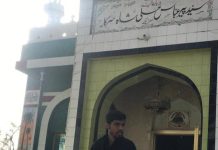Peshawar: It is evening and Professor Mohammad Rafiq is ready for his daily stroll down the narrow crowded streets of the old city in Peshawar. He asks me to come along as a couple of his friends join in for the routine walk.
Rafiq, 70, has lived all his life here in the ancient quarters of the old city, its dark and narrow streets that are cool even on the hottest of days. As we enter the crowded Bazaar of Karimpura, walking up to Ghanta Ghar – the Clock Tower, and onward to Chowk Yadgar, the heart of the walled city, Rafiq grows reflective.
“50 years ago, when I would visit these places along with my friends, it was a different city altogether,” says Rafiq, a retired professor of English professor. “People would leave their homes to come out in the evenings – the open heart of the city where the people would mix freely cultivated a bonhomie that gave Peshawarites that distinct identity.”
Even when the old city and its ancient streets throbbing with life around the clock still evoke a mystique characteristic of old quarters anywhere in the world; much has changed as Peshawar’s population has exploded over the years. In recent years, the old city has come to bear the look of a frenzied ant-hill, its roads clogged with traffic of men and machine.
“Back then the roads were open and uncrowded,” says Professor Rafiq. “The Ghanta Ghar was an imposing sight visible from a distance, tall and grand. But things started changing with time. Commercialization patronized by political forces changed the shape of Peshawar. Peshawar lost its colour and beauty.”
The Ghanta Ghar or the clock tower was built in 1900 when Peshawar was part of united India under the British Raj, in commemoration of the diamond jubilee of Queen Victoria’s rule in England. The tower was named after Sir George Cunningham, the former Governor of the Province – then the North West Frontier Province.
However tonight, as we walk past the street or ironmongers opposite the vegetable market where shops are closing for the day, Professor Rafiq speaks of “having that old feeling once again.”
“Though not completely, things have improved a lot over the last few months,” says the professor, referring to the removal of illegal constructions and encroachments from the bazars of old city under a drive started by the district authorities.
“The anti-encroachment drive launched by the government aims at sprucing up the old city which has become congested over the years,” Syed Zafar Ali Shah, the administrator of the Municipal Corporation Peshawar (MCP), told News Lens.
The public in general and the people of old city, says Zafar, appreciate the government’s move. “We have started the drive two months ago and so far we have removed 400 illegal shops and kiosks in different city bazaars.”
These include the old bazaars of Hasthnagri, Kochi Bazaar, Meena Bazaar, Karimpura, Misgiran Bazaar, Pepal Mandi, Namak Mandi, Dabgari, Bala Manri and others. The drive was jointly carried out by the Revenue department, MCP, Peshawar Development Authority (PDA) and Water and Sanitation Services Peshawar (WSSP).
The drive however evoked a mixed response from the traders and politicians. Ghulam Ahmad Bilour, a senior leader of the Awami National Party (ANP) and a member of national assembly Ghulam, was critical of the drive. “The Pakistan Tehreek-i-Insaf (PTI) government is snatching sources of income from people on the pretext of anti-encroachment drive in the city,” he said.
Bilour said the government should have arranged an alternative place for vendors and businessmen before launching the anti-encroachment drive in Peshawar. “90 percent of those affected by the drive belong to the most neglected segments of the society,” he said.
The locals had a different view, however. They expressed satisfaction over the drive and appreciated the government’s drive to take on the encroachers and builders for constructing illegal buildings.
“Walking through the streets had become quite difficult, leave alone driving in the city,” says Hamid Iqbal, a resident of Karimpura Bazaar in the walled city. “Women were the most affected due to the encroachments as it was almost difficult for them to shop in the crowded bazaars.”
Zara Hussain, a law graduate, says it was daunting for women to walk through the bazaars. “There was no room for pedestrians to move,” she remarks. “The government has taken a very good step and people from all walks of life should support such initiatives.”
According Zafar Ali Shah, the administrator of the Municipal Corporation Peshawar (MCP), the traders had reservations about the anti-encroachment drive initially. “However the district authorities had meetings with them and took them into confidence,” he said.
Shahid Khan, president of Tajir Insaf Union – a union of traders – said the drive was started with their consent. He was critical of the authorities however for not cleaning the debris scattered in the entire city in the wake of the drive.
“They (government) had promised us that the debris of the encroachments would be removed immediately and it would also compensate the shopkeepers who removed the encroachments by themselves,” he said. “As you can see, the entire city is strewn with debris and the traders are still waiting for authorities to remove it.”
Zafar Ali Shah contested the trader union’s claim saying the authorities were actively working on removal of debris and had removed more than 750 trolleys of debris from various parts of the city.
When the government started the drive in January this year, three people were killed and two injured during a clash between shopkeepers and employees of the Peshawar Municipal Corporation over the removal of encroachments at Ghanta Ghar. The violence put a temporary halt to the drive. However, after the government paid compensation money to the victims’ families, the authorities resumed the drive.
About providing alternate spaces for vendors, the MCP administrator said the shopkeepers of Ghanta Ghar were accommodated in Ganna Mandi Bazaar of old city. He said the government had planned to construct six multi-story markets in different parts of the city where all the vendors would be accommodated. He said all the bazaars would be revamped, adding to the beauty of the city.



